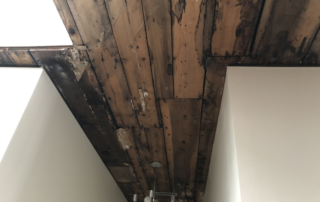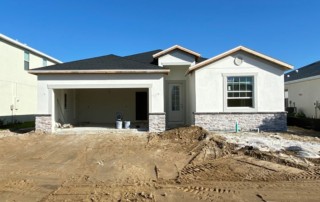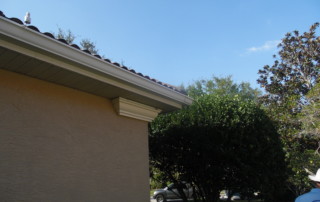Any suspicious growth on your roof may pose danger to its longevity. Sometimes it can be hard to distinguish whether the culprit is roof mold or algae.
In this article, Bill of Markham Services takes a closer look at the differences, possible damages, and ways to combat the uninvited guests invading your roof.
Does my roof have mold damage?

Mold damage has many faces. Before internal leaks, you might discover rotting roof shingles or shakes that haven’t given way to allow the water inside the house yet.
Remember that when the water enters the attic, there’s a great risk of having to deal with multiple mold colonies. The first is the original colony that made the wood rot, but the second problematic area is inside the home.
Carpeting and wood flooring provide the perfect environment for the spores to begin germinating. If you notice any leaks, then the problem has already become quite severe. There are many signs indicating the high risk of experiencing internal leaks.
Peeling paint and plaster along the ceiling and upper walls or around the dormer windows is a clear sign that water has intruded these areas. A musty smell in the attic should raise concerns as well. Even more so when the smell is accompanied by mildew growing inside the house.
Sometimes though the signs are a little more subtle. Check for discoloration and watermarks in the attic room might indicate that you are dealing with a leak.
How to minimize the damage?
 In some extreme conditions, it’s nearly impossible to stop the mold growth. That’s why it’s useful to know a thing or two about mold damage prevention. It’s essential to keep your roof in the best shape as possible.
In some extreme conditions, it’s nearly impossible to stop the mold growth. That’s why it’s useful to know a thing or two about mold damage prevention. It’s essential to keep your roof in the best shape as possible.
Check your home regularly for any issues that should prompt you to act quickly and then get it fixed immediately. Having a lot of trees around the house is good for providing shade, yet not having enough sunlight raises the risk for mold growth.
Keep the trees trimmed! And debris inside the rain gutters is an ideal home for mold colonies. Improperly functioning gutter systems raises the humidity on your roof, creating favorable conditions for mold growth and spread.
Roof mold, algae, moss, or mildew?
 People tend to mix up these four offenders infesting the roofs. While they might look similar to the untrained eye, you should still know the differences. For example, mold is a more serious problem compared to algae growth. There’s one common denominator, though – all of them need plenty of dampness to grow. That’s why all of the roof mold invaders are most common in rainy or humid regions.
People tend to mix up these four offenders infesting the roofs. While they might look similar to the untrained eye, you should still know the differences. For example, mold is a more serious problem compared to algae growth. There’s one common denominator, though – all of them need plenty of dampness to grow. That’s why all of the roof mold invaders are most common in rainy or humid regions.
Here are the differences between these different growths.
Mold
Out of the four, mold is the most troublesome. While algae and moss may provide an aesthetic value in some places, mold is an entirely unwanted guest. You can recognize mold by blotches that appear to be brownish black or dark-green. Drywall and wood offer the best surfaces for mold colonies to multiply and expand. In addition to health hazards, mold gives off a nasty smell.
Algae
Algae is very often mistaken for mold. Both mold and algae may look dark green bordering on black. Usually, algae grow on wood shingles or shakes because they prefer damp and shady places. While it’s true that algae aren’t dangerous like mold, it can still easily cause the shingles to completely rot away. That’s why it’s important to address algae growth as well.
Mildew
Mildew grows in a warm and wet environment. It’s spreading quite fast, which is why you should react quite quickly after spotting any problematic areas on your roof. Usually, mildew looks powdery and can come in many colors, including grey, black, and light red. Mildew may also have negative health effects on long-term exposure.
Moss
Moss is the most easily recognized roof growth. On some roofs, moss may look attractive because it carries a close-to-nature feel associated with forests and wilderness. Still, moss isn’t entirely benign. Too much moss makes the wood shingles rot because the expanded growth attracts a lot of moisture to the covered surface. Dealing with moss depends on your home’s design and purpose, but the potential hazard on the roof’s structure should be noted in any case.
How to identify roof mold damage?
 Mold damage should be identified before it creates further issues like internal leaks. Discoloration and rot accompanied by musty smells are tell-tale signs of the roof mold damage in progress.
Mold damage should be identified before it creates further issues like internal leaks. Discoloration and rot accompanied by musty smells are tell-tale signs of the roof mold damage in progress.
In some areas, it’s difficult to completely stop the mold growth due to the constant humidity. If that’s the case for you, here are some ways you can keep mold at bay. Consider trimming the trees around the house, keep the rain gutters free from debris, and fix any roof issues that come up.
Finally, try to understand the differences between mold, algae, mildew, and moss. Some of them are easier on your roof and health than others, although, all of them raise the risk of rotting your home.



